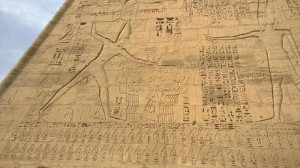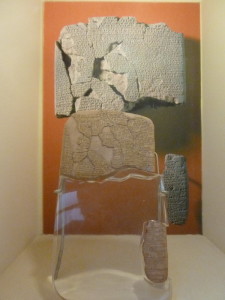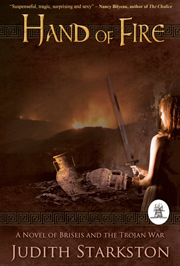 Relevant History welcomes Judith Starkson, who writes historical fiction and mysteries set in Troy and the Hittite Empire. Her debut, Hand of Fire, set within the Trojan War, combines history and legend in the untold story of Achilles’ captive Briseis. Hand of Fire was a semi-finalist in the prestigious M.M. Bennett’s Award for Historical Fiction. Starkston’s upcoming mystery series features Queen Puduhepa of the Hittites and won the San Diego State University Conference Choice Award. Puduhepa signed the first surviving peace treaty in history with Pharaoh Ramesses II; now she’s a sleuth. Ms. Starkston is a classicist (B.A. UC, Santa Cruz, M.A. Cornell). For more information, visit her web site, and follow her on Facebook, Twitter, and Goodreads.
Relevant History welcomes Judith Starkson, who writes historical fiction and mysteries set in Troy and the Hittite Empire. Her debut, Hand of Fire, set within the Trojan War, combines history and legend in the untold story of Achilles’ captive Briseis. Hand of Fire was a semi-finalist in the prestigious M.M. Bennett’s Award for Historical Fiction. Starkston’s upcoming mystery series features Queen Puduhepa of the Hittites and won the San Diego State University Conference Choice Award. Puduhepa signed the first surviving peace treaty in history with Pharaoh Ramesses II; now she’s a sleuth. Ms. Starkston is a classicist (B.A. UC, Santa Cruz, M.A. Cornell). For more information, visit her web site, and follow her on Facebook, Twitter, and Goodreads.
*****
Getting to the truth in wartime has always been challenging. Governments save face and misrepresent their military strength and their moral rectitude as combatants. As a child, I remember the photographs of the My Lai massacre in Vietnam undermining my own sense of my government’s position in that unfortunate war.
Ancient propaganda in stone
 [Ramesses smiting the Hittites, Ramesseum, Photo by Morgana] In Egypt following the Battle of Kadesh in 1274 BCE, Pharaoh Ramesses ordered a version of this battle carved onto walls of his Ramesseum, his memorial temple to himself (as well as some other buildings—repetition was a virtue in his propaganda efforts). The Pharaoh, giant-sized, is shown crushing the very tiny Hittites single-handedly with his scepter. You would assume from this grand and heroic scene that Ramesses had retaken all the disputed lands in Syria from the Hittites, that he was the undisputed victor. Pharaohs get to tell history their way in their own land. Who’s going to argue with a god who rules the land with absolute authority? (More or less, putting aside those pesky uppity priests and internecine family squabbles, etc.)
[Ramesses smiting the Hittites, Ramesseum, Photo by Morgana] In Egypt following the Battle of Kadesh in 1274 BCE, Pharaoh Ramesses ordered a version of this battle carved onto walls of his Ramesseum, his memorial temple to himself (as well as some other buildings—repetition was a virtue in his propaganda efforts). The Pharaoh, giant-sized, is shown crushing the very tiny Hittites single-handedly with his scepter. You would assume from this grand and heroic scene that Ramesses had retaken all the disputed lands in Syria from the Hittites, that he was the undisputed victor. Pharaohs get to tell history their way in their own land. Who’s going to argue with a god who rules the land with absolute authority? (More or less, putting aside those pesky uppity priests and internecine family squabbles, etc.)
Reality on the Hittite side
However, the Hittites, Ramesses’ foes, were no weaklings, even if they didn’t leave a pictorial version of their own of this key battle. A close look at the aftermath of Kadesh shows that Ramesses engaged in some unjustified propaganda.
First of all, you may be wondering who the Hittites were. Ramesses, of “let my people go” Moses fame (if we can stray from history into possibly legendary material), is a relatively familiar character from the dust pile of history. But there’s a good chance you haven’t heard of Great King Muwattalli and his younger brother and most reliable general, Hattusili. The Hittite Empire sprawled from the western Aegean coast of what is now Turkey across the Anatolian plateau and down into what is now Syria and Lebanon. The Hittite Great King and the Egyptian Pharaoh addressed each other as “Brother” in recognition of their equal power. Sometimes a Babylonian or Syrian king got to claim such lofty status, but not always. So the fact that the Egyptian kingdom stretched up into the Levant and the Hittite Empire stretched down into the Levant, and thus they butted up against each other was just sure to cause trouble.
Ramesses, early in his reign, was determined to match the heroic achievements of his predecessors after a generation or two of less than heroic pharaohs dimming the glory of Egypt’s martial reputation. He made a series of raids into these disputed areas in 1275 and then launched a full-scale war in 1274. Muwattalli was ready for him. More ready than the inexperienced Ramesses, as it turns out.
The battle
In his eagerness to take back his Syrian territory, Ramesses launched ever northward, ahead of his main fighting divisions. Not far from Kadesh, he found two Bedouins who claimed to want to leave the service of the Hittite Great King and join the Egyptians. They explained that Muwattalli’s army was far away in the Land of Aleppo. Ramesses took them at their word, sent no scouts out, and crossed the river (thus separating himself even more from his troops who hadn’t made it there yet) to set up camp outside Kadesh.
Actually, the Hittite main force was camped on the far side of Kadesh. They made a secret attack and nearly wiped out the whole Egyptian army. The eminent historian Trevor Bryce describes what happened next: “Ramesses, making up for his earlier recklessness and gullibility, stood his ground with an exemplary show of courage and leadership—at least according to his own version of the events” (The Kingdom of the Hittites p. 237).
How much this turn of the battle was due to Ramesses’ personal leadership skills in battle and how much was due to the timely arrival of some Egyptian reinforcements will forever remain debatable. But what we do know is that Ramesses listed the slain Hittite officers on the walls of the Ramesseum, and we have no reason to doubt the accuracy of that part—the Hittites took huge losses. We also know that the Hittites avoided renewed conflict, which again shows the losses they must have suffered in men and weaponry.
The long-term result: peace
 [Treaty of Kadesh between Ramesses and Hattusili/Puduhepa]It was a war whose large scale had done permanent damage to both sides, and these two sides eventually signed the first extant peace treaty in history, which you can see in the Istanbul Archaeological Museum. By that time, younger brother Hattusili was Great King and his indomitable wife, Puduhepa, also placed her seal on this treaty. Queens got a lot of respect among the Hittites, not at all like most of their ancient contemporaries.
[Treaty of Kadesh between Ramesses and Hattusili/Puduhepa]It was a war whose large scale had done permanent damage to both sides, and these two sides eventually signed the first extant peace treaty in history, which you can see in the Istanbul Archaeological Museum. By that time, younger brother Hattusili was Great King and his indomitable wife, Puduhepa, also placed her seal on this treaty. Queens got a lot of respect among the Hittites, not at all like most of their ancient contemporaries.
The key to understanding who “won” Kadesh lies in the spoils. The Hittites regained control of some cities that had recently fallen into Egyptian influence and they took control of several cities that had always been in the Egyptian camp. Does not sound like an Egyptian win. The eventual treaty does not spell out the boundaries in detail, but it leaves in place the status quo after Kadesh—noticeably in Hittite favor.
So whatever you see while touring the famous temples and mausoleums of Egypt, the Hittites came out marginally ahead. Both sides came out chastised into peacemaking. Wouldn’t it be nice if some of those currently engaged in self-destructive wars in this same region today came to a similar conclusion? Maybe they should read some history.
*****
 A big thanks to Judith Starkson. She’ll give away a paperback copy of Hand of Fire to someone who contributes a comment on my blog this week. I’ll choose the winner from among those who comment by Friday at 6 p.m. ET. Delivery is available in the U.S. only.
A big thanks to Judith Starkson. She’ll give away a paperback copy of Hand of Fire to someone who contributes a comment on my blog this week. I’ll choose the winner from among those who comment by Friday at 6 p.m. ET. Delivery is available in the U.S. only.
**********
Did you like what you read? Learn about downloads, discounts, and special offers from Relevant History authors and Suzanne Adair. Subscribe to Suzanne’s free newsletter.

Fascinating time period and I can’t wait to read! And I recall seeing that very picture of Ramesses on my visit to Egypt, where I felt submerged in ancient history–what a thrill.
The good news is my mystery series about Puduhepa is drawing editor interest and should be available not too far down the road.
If you enjoy this period and ancient history in general, you might want to email subscribe to my website. I do a short round up each week of intriguing posts regarding archaeology and historicals. (And you’ll know first when Puduhepa debuts as a sleuth!) http://www.judithstarkston.com/
While researching background for my book, The Thirteenth Moon, that takes place 1020-900 BC in Canaan, Egyptian and Hittite influences were still present, in archetecture as well as in cultic practices and the confluence of gods and goddesses. One of my characters is Hittite…which drew me into a whirlwind and thrilling study of his background in Hattusa. He is a skilled metalworker of gold and brass…and so I named him Hasameli, after the Hittite God of metalworkers. His son is Mursili…after the king you mention in your blog! L
Judith, you have chosen a fascinating and little known culture. Your meticulous research is obvious.
Canaan is a very interesting place both during your later period and earlier when my books are set. Everyone tromped through there and generally wanted a piece of it for themselves. I can imagine you had to account for many cultural influences. I’ve been researching a book set in Cyprus and I know many artifacts from Cyprus are regularly found in Canaan as well as the Egyptian and Hittite ones you mention. Sounds like a fascinating book.
Great summary, Judith, thanks! And for those who have not already had the pleasure of reading it, Hand of Fire is a splendid book.
Thank you very much, Richard. Glad you enjoyed Hand of Fire. In my current manuscript that my agent has at this point, Ramesses, Hattusili and Muwattalli all have roles, so their encounter at Kadesh is of great interest to me. I’m particularly interested in Puduhepa who is now a sleuth in my new series.
Just fascinating. The more one studies history, the more nuanced the world becomes. I’m going to download a copy. Please don’t put me in the drawing. My eyesight requires an ebook and someone else can enjoy the print edition.
Thanks for sharing this informative article. I like reading stories set in Ancient Egypt.
I just finished a book by Wilbur Smith who write stories of this time period.
My books aren’t actually set in Egypt but rather the Hittite Empire (modern Turkey) and it’s actually the series that’s not out yet that you’d be interested in because it’s the one with the Egyptian connection with the war with Egypt. Just so you know! I wouldn’t want to make for an unhappy reader with false expectations
This sounds like a fascinating read! Shame we can’t learn more from history, because it DOES repeat itself (probably because we don’t learn more from it).
In this historical case the parallels are painfully clear, but no one in decision making positions is paying any attention as far as I can tell…
They have their Priorities, and history, alas, is not one of them.
Oh, I’ll have to send this link to my elder son! He’s an ancient history and wargaming buff with a particular interest in the Hittites. I’ve joked with him once or twice that he ought to write a historical mystery series set in the Hittite Empire; I’m overjoyed to hear that someone is actually doing it!
I’m always tickled to find another person interested in Hittites. He might want to subscribe to my website, although I tend to focus less on the battles on the field of war and more on the battles everywhere else in daily life, ancient or otherwise. I do love the trick the Hittites managed to pull on Ramesses at Kadesh, though. That’s a battle worth writing!
Thanks for this glimpse into ancient Hittite culture! I love ancient cultures and learned quite a bit from this blog post. I’m looking forward to reading your book to learn more!
One gets the sense that Ramesses wasn’t as Great as he made himself out to be. I can’t wait for the Puduhepa series.
interestingly enough, Rameses’ actual campaigns were almost entirely limited to the first few years of his very long reign. One might speculate that the Qadesh experience dulled his enthusiasm for real campaigning. After those first few years, the only positive evidence we have for him being military relates to flag-waving exercises in the nearer parts of Canaan. The rest of the time was focused on internal matters – and of course the construction of large numbers of large monuments celebrating his earlier actions. To be fair, the wording of Egyptian monuments is largely conventional, using a high level of stock words and phrases. It is not until rather later in Egyptian history that we get what you might call a more sober reflection of the battles fought.
Hi Laura. My read of Ramesses definitely shades to the blindly arrogant side and I think later reality kind of caught up to him so that he was forced to make peace with Hattusili and Puduhepa but always with a sour grapes attitude. He wrote some pretty snarky letters to them which Puduhepa scolded him for. But she saw the advantages of peace and made it happen. Go figure, the woman has the sense to boss a couple men into behaving for the benefit of their people.